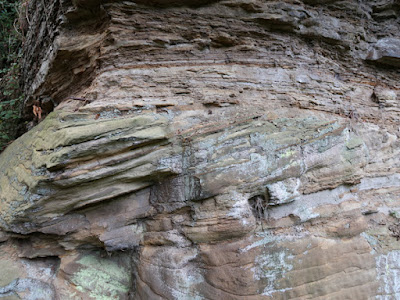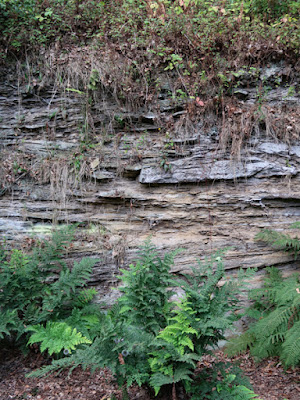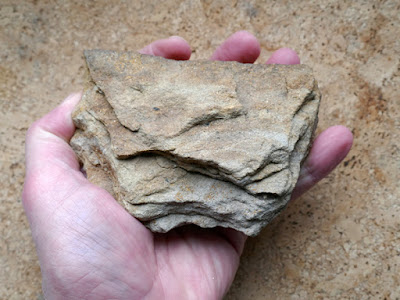 |
| A detail of trough cross-bedding |
Having had a good wander around the grounds of Nostell Priory to photograph various buildings for the British Listed Buildings website, on the approach to the summer house I was interested to see an exposure of very thinly bedded sandstone alongside the path.
Continuing down into the gardens, further small exposures soon turned into a distinct vertical rock face and it became obvious that I was entering an old quarry, which I later discovered was transformed into a menagerie in 1743.
The Building Stones Database for England map explorer shows that several quarries worked the Ackworth Rock around Brackenhill/Ackworth Moor Top and, when examining St. Michael’s church and various historic buildings on the Nostell Priory estate, I could readily identify this sandstone.
The quarry was designated as a Local Geological Site by the West Yorkshire Geology Trust (WYGT) back in 2012 and, according to their site description, the Augustinian priory (c.1130) was probably built from sandstone from this quarry.
The LIDAR map shows that the quarry was quite substantial and the geological memoir records it as showing 15 feet of fine grained and wedge bedded sandstone in the measures between the Shafton Marine Band and the Ackworth Rock. WYGT further describes it as being fine-grained, pale grey and yellow in colour and containing cross-bedded sets, with erosive scours being common at the bases.
There is nothing left of the priory buildings and although, in my 1967 edition of the Buildings of England West Yorkshire Riding, Pevsner notes that “Mr Pace tells me that many stones, carved and moulded, are stored in outbuildings,” as far as I am aware, it is not possible to observe the characteristics of this masonry.
Looking at one part of the old quarry, two old faces form a right angle and the trough cross-bedded sandstone is overlain by very thin beds of silty sandstone that is differentially weathered and would not be very suitable for building.
Since alighting from the No. 496 bus at Foulby a few hours before, I had encountered several things that interested me as a geologist: handmade bricks made from local clay, many examples of the use of Ackworth Rock as a building stone – a formation that I was not very familiar with - and various sedimentary structures.
WYGT describes the quarry as an ideal site for educational groups to observe sandstones and their features and, added to the above, I am sure that it would be appreciated by members of the Sheffield U3A Geology Group, but I am not sure that the National Trust would allow group visits to the garden, when the general public are normally charged £8 each.
From one of the quarry faces where the rock was loose, I was able to obtain a sample that is fine grained, brown/grey in colour with iron staining and Liesegang rings adding orange/brown colour variations. It is also thinly bedded and very small grains or white mica are clearly visible on several exposed bedding planes.
At the southern entrance to the Menagerie Garden is the Gothick Arch, which was probably built at the same time as the menagerie and is made of a very poor quality rubble sandstone that I suspect was taken from the quarry at the time.
The minor Coal Measures sandstones very often contain a considerable quantity of silt and these are usually only suitable for very basic walling stone, with limited massive sandy beds that could be used for well squared walling and dressings.












No comments:
Post a Comment